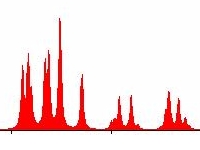
Many chemical and physical methods for the analysis of compounds in solution and/or the solid state yield one-dimensional spectra or diagrams that consist of isolated and/or (partly) overlapping sharp peaks. Examples of such spectra are 1D-NMR spectra and powder diffraction patterns. In the case of powder diffraction patterns the positions of the peaks are very sensitive to small deviations in unit cell parameters. This means that in the case of crystal structure prediction, or ab initio structure determination, strongly related structures may give (calculated) powder diffraction patterns that look similar from an overall point of view but differ significantly on a more local scale. The same situation may occur for isomorphous compounds that differ only slightly in unit cell volume or unit cell shape. These compounds may give experimental or calculated powder patterns that by visual inspection are definitely related and recognizable as isostructural compounds. Unfortunately, in all those cases the calculation of a reliable and objective measure of similarity or dissimilarity, even when the whole pattern is considered, is non trivial.
We developed a new similarity criterion, that is based on correlation functions. It was succesfully demonstrated for powder diffraction patterns corresponding to a series of crystal structures of cephalosporin complexes.
The similarity concept provides a general method for quantifying the match between spectra of various physical and chemical techniques for the analysis of matter. The applicability of the new similarity criterion lies in the field of pattern classification, data-base searching and optimization problems. Its recent successful use in the direct determination of molecular constants from rovibronic spectra with genetic algorithms is described by Hageman, Wehrens, De Gelder, Meerts and Buydens.
This is an example of Pattern Matching research in Chemical Crystallography.
See also research in Chemical Crystallography.
References